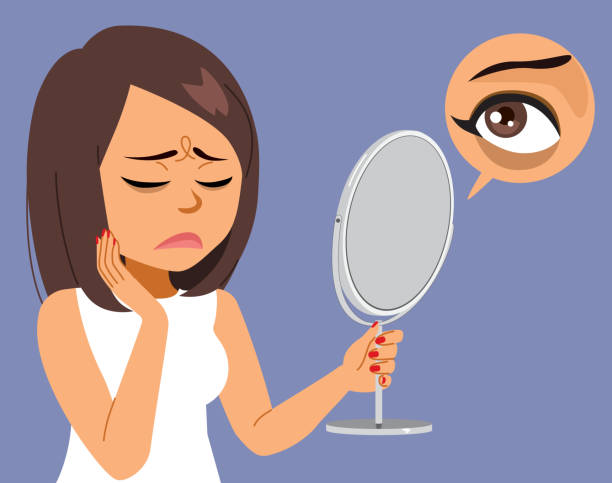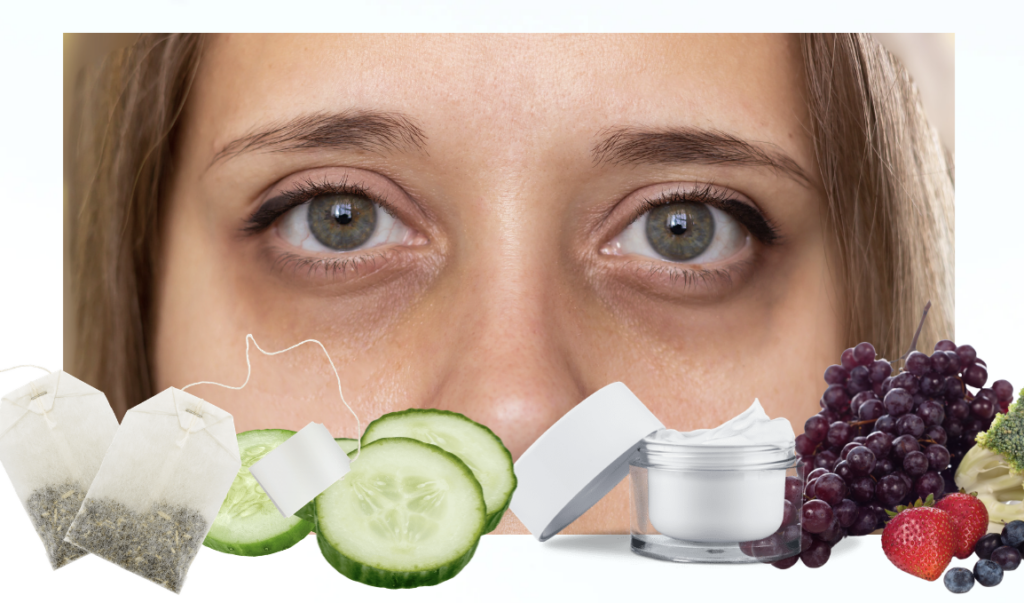Skin Care
Say Goodbye To Dark Under Eyes With Natural Solutions
Dark under eyes, also known as “bags” or “panda eyes,” can have a negative impact on one’s appearance and confidence. While they are a common issue for many people, the search for an effective cure frequently results in a flurry of skincare products packed with chemicals and promises of rapid remedies. However, among the sea of cosmetic remedies, the different natural solutions to treat dark under eyes appear as an interesting option.
In this article, we will look at natural solutions for dark under eyes. From introducing nutrient-rich foods and herbal medicines into your diet to following lifestyle behaviors that promote skin health and renewal, we look at the holistic approaches that have the potential to brighten the shadows behind the eyes. Join us as we discover how to achieve a rejuvenated and renewed appearance with mild, natural therapies that respect the body’s innate healing capacities.

Understanding Dark Circles
Dark circles around the eyes are a prevalent cosmetic problem among many people. They are distinguished by the presence of dark, discolored patches under the eyes, which can make the individual appear fatigued or older than their age. In this section of the article, we’ll look at the causes of dark circles, the impact of lifestyle, and the genetic and age-related factors that influence their development.
Causes of Dark Circles
There are various things that might lead to dark circles under the eyes. Some of the most common causes are:
- Genetics have a substantial impact on the development of dark circles. People with darker skin tones are more likely to develop dark circles because their skin has more melanin, which causes discoloration.
- As we age, our skin thins, and blood vessels behind the eyes become more noticeable. This can lead to the appearance of dark circles.
- Allergies can induce inflammation and swelling in the eyes, resulting in dark circles.
- Sun exposure can darken the skin around the eyes, resulting in dark circles.
- Dehydration can lead to dry, drab skin, making dark circles more prominent.
Impact of Lifestyle
Several lifestyle factors can lead to the formation of dark circles. Some of the most common factors are:
- Stress can lead to dull and weary skin, highlighting dark circles.
- Alcohol and smoking can enlarge the blood vessels under the eyes, resulting in dark circles.
- Iron deficiency and anemia can lead to pale skin, making dark circles more prominent.
Genetic and Age-Related Factors
Aside from lifestyle and environmental causes, dark circles can also be caused by hereditary and age-related factors. Some of the most common factors are:
- Irregular pigmentation under the eyes can produce discoloration, resulting in dark circles.
- Dark circles can be caused by increased visibility of capillaries and blood vessels under the eyes with age.
- Eczema and inflammation can lead to red and puffy skin, highlighting dark circles.
In conclusion, dark circles around the eyes are a typical cosmetic issue that can be caused by a number of circumstances. Understanding the causes and effects of lifestyle, genetic, and age-related variables might help people prevent or minimize the formation of dark circles.

Natural Solutions and Lifestyle Changes
Genetics, aging, and lifestyle choices are all potential causes of dark circles beneath the eyes. Fortunately, there are various natural solutions and lifestyle adjustments that can aid in the reduction of dark circles under the eyes.
Diet and Hydration
Diet and hydration are crucial for maintaining good skin and minimizing the appearance of dark circles. Drinking enough water might help to moisturize the face and minimize puffiness around the eyes. Furthermore, eating foods strong in antioxidants and vitamins, including as fruits and vegetables, can help improve circulation and boost collagen formation, thereby reducing the appearance of dark circles.
Sleep and Rest
Sleep and rest are essential for keeping your skin healthy and minimizing the look of dark circles. Lack of sleep and fatigue can make the skin appear dull and lifeless, highlighting dark circles. To lessen the appearance of dark circles, obtain enough sleep and rest, and prevent sleep deprivation.
Home Treatments
There are a few home remedies that can help decrease the look of dark circles. Using a cold compress, such as tea bags or cucumber slices, can help reduce puffiness and irritation around the eyes. Additionally, using a moisturizer containing caffeine, vitamin K, or antioxidants can aid in circulation and lessen the look of dark circles. Elevating your head while sleeping can also help minimize puffiness and avoid fluid buildup around the eyes.
Overall, natural solutions like lifestyle adjustments can help reduce the appearance of dark circles under the eyes. However, it is crucial to note that dark circles can sometimes be caused by underlying medical illnesses, including as allergies or thyroid issues. If home therapies do not relieve the appearance of dark circles, you may need to contact a doctor.

Professional Treatments and Consultations
There are numerous medical and cosmetic procedures available to help minimize the look of dark under eyes. In some circumstances, seeing a dermatologist or doctor may be required to discover the underlying source of the dark circles and the best treatment choice.
When to See a Dermatologist
If dark circles under the eyes continue despite lifestyle modifications and other natural solutions, it may be necessary to seek professional assistance. A dermatologist can assist in identifying the underlying cause of the dark circles and offer appropriate therapies.
Medical Treatments and Surgery
Fillers, laser therapy, chemical peels, and surgery can all help to minimize dark circles and under-eye bags. Fillers like Restylane and Juvederm can fill in hollow spaces and encourage collagen production. Laser methods can assist in constricting blood vessels and minimize the appearance of dilated blood vessels. Blepharoplasty, a surgical operation that removes extra skin and fat from the eyelids, is also a viable therapy option.
Cosmetic Products and Alternatives
There are also various cosmetic products and alternatives available to help decrease the look of dark circles. Topical treatments like glycolic acid, kojic acid, and skin brighteners can help lighten the skin and minimize the appearance of dark circles. Tretinoin can also help to enhance skin texture and minimize the appearance of fine lines and wrinkles. Cold compresses, sunglasses, and sleeping with your head elevated can all help reduce puffiness and swelling. Sunscreen and sun protection can assist in reducing free radical damage and skin discoloration. Finally, wearing concealer can be a temporary remedy for concealing dark circles.

Prevention Strategies
Protecting the Delicate Under-Eye Skin
The skin below the eyes is thinner and more sensitive than the rest of the face. As a result, it is critical to take extra precautions to safeguard this area from harm. Wearing sunglasses outside is one of the most critical things you can take to preserve your under-eye skin. This helps to protect the skin from damaging UV radiation, which can cause premature aging and discoloration. It is also critical to wear broad-spectrum sunscreen with at least SPF 30 under the eyes to avoid skin deterioration caused by sun exposure.
Another technique to protect under-eye skin is to avoid rubbing or pushing it while applying cosmetics or skincare products. This can irritate and inflame the skin, resulting in dark circles and other skin concerns. Instead, use the ring finger to softly pat items into the skin, as it exerts less pressure than the other fingers.
Minimizing Environmental and Lifestyle Risks
Several environmental and lifestyle variables might contribute to the appearance of dark circles under the eyes. One of the most prevalent causes is a lack of sleep. Not getting enough sleep can cause the skin to become dull and pale, making dark circles more visible. As a result, it is critical to receive at least 7-8 hours of good sleep per night.
Stress is another cause that might lead to the formation of dark circles. When the body experiences stress, it creates cortisol, which can cause inflammation and skin damage. As a result, it is critical to develop stress-management strategies, such as meditation, exercise, or other relaxation techniques.
Finally, be aware of any allergies or skin problems that could be contributing to the formation of dark circles. Eczema, allergic rhinitis, and atopic dermatitis are all possible causes of dark circles. If you feel you have an underlying skin condition, you should consult with a dermatologist to receive the appropriate therapy.
Conclusion
Finally, seeking natural solutions to dark under eyes provides a novel approach to skincare that stresses overall well-being and nourishment. Individuals can address dark circles under the eyes with gentle yet effective approaches by eating nutrient-rich meals, using herbal therapies, and adopting lifestyle behaviors that promote skin health and renewal. While outcomes may vary based on individual factors, the holistic approach to skincare tackles both symptoms and underlying causes, resulting in long-term benefits in skin appearance and general vitality. As we continue to investigate the relationship between nature and beauty, including natural solutions for dark under eyes provides a sustainable and harmonious path to radiant and revitalized skin.
https:/discoverybody.com

